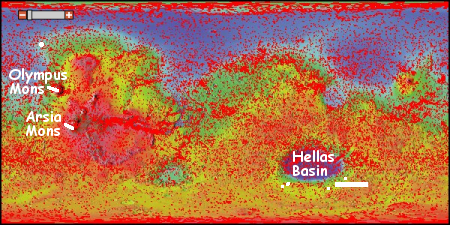The expanding range for Martian ice scarps
The discovery in January 2018 of a number of Martian cliff faces, or scarps as the scientists dubbed them, with a visible and apparently very accessible underground layer of ice, had significant ramifications.
First, it proved that, in at least one area south of Hellas Basin and one spot in the northern hemisphere, an underground ice table existed on Mars at latitudes as far south as 55 degrees. Scientists had theorized that this ice table, comparable to the water table on Earth, existed, but here was visible proof.
Second, the discovery showed places where water could be accessed relatively easily by future colonists. There are plenty of indications from orbiter images and lander/rover data that water is present in many places on Mars, but here the water appeared almost pure and could be obtained without major digging or processing. Whether that ice table extends even farther south, making it even more accessible, remains as yet a scientific question.
In the next few months the scientists involved in this research located more ice scarps in areas beyond the range of those initial discoveries. Since then however even more scarps have been found, including the scarp in the image above and to the right, cropped, reduced, and annotated to post here.
This particular scarp is located inside a crater. The uncaptioned release from the high resolution camera on Mars Reconnaissance Orbiter (MRO), described it as a “Scarp in mantling material.” According to Colin Dundas of the U.S. Geological Survey’s Astrogeology Science Center in Arizona,
It does appear that there is ice in that scarp, since there is material that is relatively bright in the HiRISE blue-green filter and the morphology matches other exposures. “Mantling material” refers to the partially eroded smooth unit that covers a large part of the image, which seems to drape and bury much of the surface–the scarp is cut into that material, suggesting that the mantle here is mostly ice.
That mantling material is essentially the visible crater floor, which Dr. Dundas suggests is “mostly ice,” and thus very very accessible.
Dr. Dundas also noted that “There are a couple of other scarp exposures in this area [and] mapping and characterizing them is an ongoing project.” With that hint, I started to go through the HiRise archive, and was quickly able to locate a few more newly imaged ice scarps, including one in the very same crater but slightly to the north, and a second in another nearby crater to the west.

I doubt I have located all the new scarps found by Dr. Dundas and other scientists, since my review of the MRO archive was not that thorough. However, what I found with these new scarps is that the known range of scarps continues to grow. The map on the right is a revision of the overview map I created in January, with these new ice scarps indicated by the white boxes south of Hellas Basin and mostly west of the long horizontal bar (the previously known scarp range).
While the newly discovered scarps are mostly at the same latitude, about 55 degrees, the range is widening to the west, suggesting that with time we are going to discover that they exist in a band that circles Mars at this latitude.
For future colonists, this information is critical, and suggests that the first future bases could very well be located along this band.
On Christmas Eve 1968 three Americans became the first humans to visit another world. What they did to celebrate was unexpected and profound, and will be remembered throughout all human history. Genesis: the Story of Apollo 8, Robert Zimmerman's classic history of humanity's first journey to another world, tells that story, and it is now available as both an ebook and an audiobook, both with a foreword by Valerie Anders and a new introduction by Robert Zimmerman.
The print edition can be purchased at Amazon or from any other book seller. If you want an autographed copy the price is $60 for the hardback and $45 for the paperback, plus $8 shipping for each. Go here for purchasing details. The ebook is available everywhere for $5.99 (before discount) at amazon, or direct from my ebook publisher, ebookit. If you buy it from ebookit you don't support the big tech companies and the author gets a bigger cut much sooner.
The audiobook is also available at all these vendors, and is also free with a 30-day trial membership to Audible.
"Not simply about one mission, [Genesis] is also the history of America's quest for the moon... Zimmerman has done a masterful job of tying disparate events together into a solid account of one of America's greatest human triumphs."--San Antonio Express-News



Future settlements you mean :-)